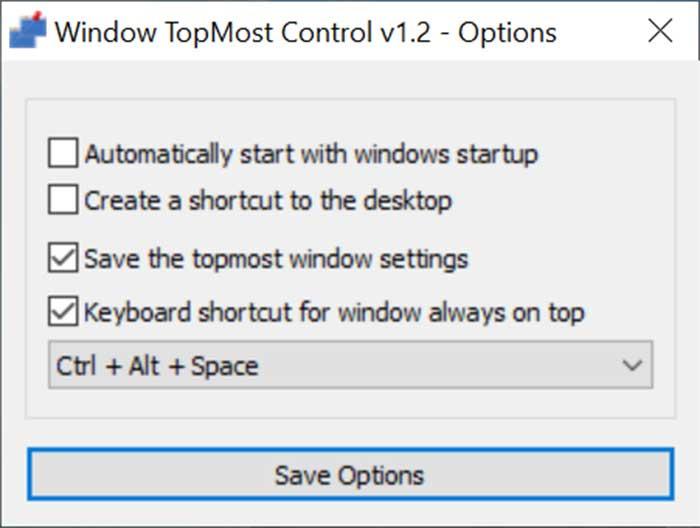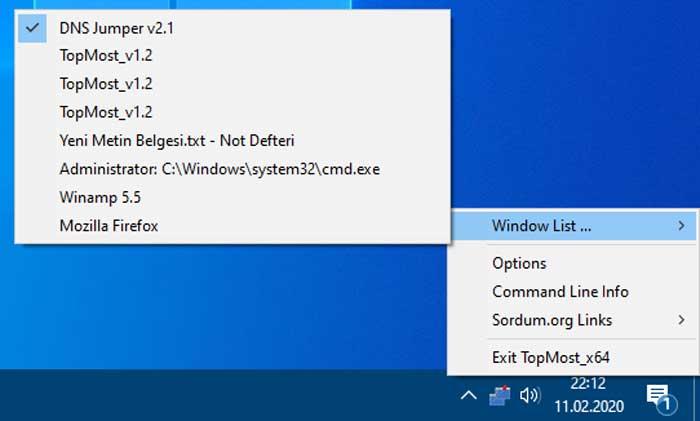window is already top most что это
Элемент управления TopMost окна: установить любое окно поверх других
Что такое и как использовать Window TopMost Control
После запуска приложения мы видим его значок на панели управления Windows. Если мы нажмем на него правой кнопкой, то увидим Доступные опции программы. в Список Windows В разделе мы найдем все окна, которые у нас открыты. Если мы хотим, чтобы какое-либо окно оставалось наверху, нам просто нужно выберите его из всего списка.
В качестве альтернативы, если мы не хотим использовать меню приложения, мы можем использовать ярлык, нажав «Ctrl + High + Пробел» заблокировать выбранное окно, и оно будет показано вверху. Если мы хотим разблокировать его, мы просто должны выбрать его снова и снова нажать ярлык. В противном случае мы бы щелкнули правой кнопкой мыши значок приложения на панели задач и сняли флажок с выбранной программы.
Окно TopMost позволяет нам настраивать программное обеспечение в соответствии с нашими потребностями, допуская параметры командной строки, как вы можете видеть на изображении ниже. Сквозь CMD Инструмент и с помощью следующей командной строки мы можем исправить любое окно на переднем плане экрана.
/ S : Устанавливает всегда фиксированное окно сверху
/ Р : Удалить окно, которое всегда сверху
/ L : Устанавливает список фиксированных окон вверху
Скачать окно TopMost Control
Альтернативы Window TopMost Control
Form. Top Most Свойство
Определение
Некоторые сведения относятся к предварительной версии продукта, в которую до выпуска могут быть внесены существенные изменения. Майкрософт не предоставляет никаких гарантий, явных или подразумеваемых, относительно приведенных здесь сведений.
Возвращает или задает значение, указывающее, отображать ли форму как форму переднего плана.
Значение свойства
Примеры
В следующем примере демонстрируется создание самой верхней формы. В примере создаются две формы, одна из которых развернута, а другая — как самая верхняя форма. Первая форма с именем bottomForm отображается в развернутом виде с помощью WindowState свойства, чтобы лучше продемонстрировать возможности самой верхней формы. Вторая форма с именем topMostForm задает TopMost свойство для, чтобы true отобразить форму в виде самой верхней формы. При выполнении этого кода щелчок развернутой формы не приведет к отображению самой верхней формы под развернутой формой. В этом примере требуется, чтобы метод, определенный в примере, вызывался из другой формы.
Комментарии
Самая верхняя форма — это форма, которая пересекает все остальные (не самые верхние) формы, даже если она не является активной или основной формой. Самые верхние формы всегда отображаются в самой высокой точке z-порядка окон на рабочем столе. Это свойство можно использовать для создания формы, которая всегда отображается в приложении, например в окне инструментов поиска и замены.
Force window to be above already top-most windows (like the Task Manager) [duplicate]
I have a window which i would like to display above everything else. My code is able to successfully force it to be above almost every window, except for other top-most windows. Here is the code I use:
This line is executed every time I click the middle mouse button (I am using a mouse hook to fire it).
Once I start up my program, and middle-click once, from that point on, my window remains above all «regular» windows.
However, all «special windows» seem to be in the same category as my application window, i.e. special windows when focused are displayed above my application window. In this category of special windows are the taskbar (which using the start menu also seems to activate), right-click menus (even when spawned by regular windows), the Task Manager, and I am sure many others. In fact I am fairly sure any other window which is «topmost» will behave this way. It seems that through my SetWindowPos call I have elevated the status of my application window to a topmost window.
What’s neat is that I can start the Task Manager, move it over my app window (so that it is now covering it) and then middle-click inside the Task Manager, and now my app window pops back up in front (while focus remains on the Task Manager). This is nice but I’d like to take it one step further so that my window will be on top no matter what.
Are there any methods to accomplish this other than repeatedly firing SetWindowPos in a loop? I’d like to avoid that if at all possible.
How to make a WPF window be on top of all other windows of my app (not system wide)?
I want my window to be on top of all other windows in my application only. If I set the TopMost property of a window, it becomes on top of all windows of all applications and I don’t want that.
19 Answers 19
You need to set the owner property of the window.
You can show a window via showdialog in order to block your main window, or you can show it normal and have it ontop of the owner without blocking the owner.
Instead you can use a Popup that will be TopMost always, decorate it similar to a Window and to attach it completely with your Application handle the LocationChanged event of your main Window and set IsOpen property of Popup to false.
I hope you want something like this:
use the Activate() method. This attempts to bring the window to the foreground and activate it. e.g. Window wnd = new xyz(); wnd.Activate();
I ran into a very similar situation as you. Most of the searches I came across stated all I needed to do was set the Owner of the windows I wish to be Topmost to the main window or whatever window that called Show.
Anyways, I’ll go ahead and post a solution that worked well for me.
I created event handlers for Window.Activated and Window.Deactived in the window that was supposed to be Topmost with respect to my application.
It works great for me. Hopefully this is useful to someone else out there. :o)
In the popup window, overloads the method Show() with a parameter:
Then in the Main window, call your overloaded method Show():
The best way is set this two events to all of windows of your app:
There are several threads, there’s even a «topmost» tag. Search on that, or go directly to this post which looks good:
I’m the OP. After some research and testing, the answer is:
No, there is no way to do exactly that.
Here’s a way to do it: make your «topmost» window subscribe to your other windows GotFocus and LostFocus events and use the following as the event handlers:
You can add this to your windows tags
Then you can also display it if you want your users to acknowledge it in order to proceed
First try it without TopMost parameters and see the results.
I too faced the same problem and followed Google to this question. Recently I found the following worked for me.
I just ran into this same issue. I have a desktop app that has multiple WPF windows, and I needed my custom splash screen to be on top of the other windows in my app only. No other windows are open when my splash screen comes up, but I do open the MainWindow from my splash screen after some authentication. So I just did something similar to what @GlenSlayden did but in code behind since, like I said, the MainWindow isn’t up for me to bind to:
Now while my program is loading all the other windows from the MainWindow, the splash screen is on top, but while the program is authenticating the user, it’s not topmost, so you can click away on some other program and it will hide behind it. It’s the closest thing I could find to a solution for this problem. It’s not perfect because it still goes over top of all other applications while my program is loading after authentication, but that’s not for very long in my case.
Here is what I added to my View Model:
Here is the XAML that implements it (I use MVVM light with a ViewModelLocator as a static resource in my app called Locator):
Win32: Bring a window to top
I have a Windows program which has two 2 windows in it:
When I double click on hwnd, I need hwnd2 to pop up and show some data, so I use this function to bring hwnd2 to top:
hwnd2 is brought to top, but there is one thing odd. When I click on hwnd2 again, hwnd (main interface) pops itself up again automatically. I tried to use the following function to solve this problem, but non of them works.
How could I solve this problem? Thanks in advance.
(for replying to aJ, hwnd2 doesn’t have parent because it needs to be a toplevel window so it can be in front/back of other windows)
(hwnd2 is a media player which is composed of several windows, one of the windows is for video dispaly, two other trackbar controls for progress bar and volume bar, one Toolbar control for control panel.)
(There is one this might help, no matter which window I click on hwnd2, hwnd pops up automatically as loong as «the mouse is on top of hwnd in Z-order», including menu bar and non-client area, etc.)
(This media player is writen in Direct Show. I use IVideoWindow::put_Owner to put video window as the video owner, Direct Show internally creates a sub-video window as a child of the video window. Except for this sub-video window which I can’t see the source code, I don’t see any thing suspicious in hwnd2.)
I found the reason, which is because of Direct Show. I use multithread to execute it, and then the problem’s solved. But. why??
This problem can be resolved by using PostMessage (rather than SendMessage).









